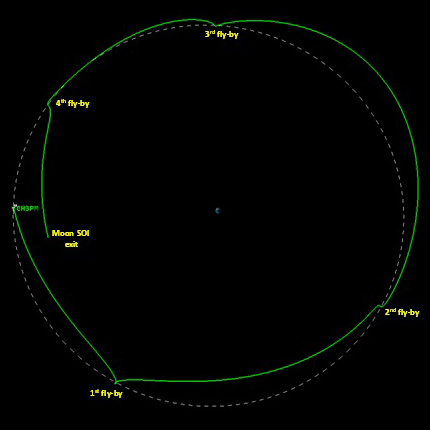NOVEMBER' 23
November 1: Lucy’s Journey
.NASA's Lucy spacecraft was embarking on an extraordinary feat during its 12-year mission to explore Jupiter Trojan asteroids. Originally scheduled to closely encounter an asteroid in 2025, Lucy will now test its groundbreaking asteroid-tracking navigation system on November 1, 2023, with a smaller, unnamed asteroid (152830) 1999 VD57. Identified by the Lucy team as a unique opportunity for validation, this asteroid, estimated to be a mere 0.4 miles (700 m) in size, is the smallest main belt asteroid ever visited by a spacecraft. Lucy's pioneering terminal tracking system, addressing the challenge of pinpointing the spacecraft's distance and orientation during an asteroid approach, promises enhanced efficiency by automatically tracking the asteroid during the encounter. The mission not only expands scientific capabilities but also sets a precedent for future flyby missions. The spacecraft's principal investigator, based in Boulder, Colorado, anticipates valuable insights from this unexpected asteroid encounter, providing crucial data for the mission's ultimate goals.

November 4-5: Taurid meteor shower
The Taurid meteor shower was composed of two streams: The Southern Taurids which peaked between Nov. 4 and Nov. 5; and the Northern Taurids which peaked between Nov. 11 and Nov. 12. These showers produced infrequent, slow and long-lasting meteors associated with comet Encke, a small comet with a nucleus measuring approximately 2.98 miles (4.8 km) in diameter. Viewing conditions for the 2023 Taurid meteor showers are good as the moon will only be 2% illuminated.

November 9: The Christmas Tree Galaxy Cluster
Scientists have discovered 14 new transient objects during their time-lapse study of galaxy cluster MACS0416 -- located about 4.3 billion light-years from Earth -- which they've dubbed as the 'Christmas Tree Galaxy Cluster.' An international team of scientists, led by the University of Missouri's Haojing Yan, used NASA's James Webb Space Telescope (JWST) to discover 14 new transient objects during their time-lapse study of galaxy cluster MACS0416 -- located about 4.3 billion light-years from Earth -- which they've dubbed as the "Christmas Tree Galaxy Cluster."Associate professor Yan from the Department of Physics and Astronomy at Mizzou discusses the fascinating field of transients, objects in space that suddenly brighten significantly and then fade away. With the advanced capabilities of NASA's James Webb Space Telescope (JWST), Yan and his team studied the galaxy cluster MACS0416, affectionately dubbed the "Christmas Tree Galaxy Cluster." The cluster's flickering lights, or transients, were initially observed with the Hubble Space Telescope. The transients were revealed through gravitational lensing, magnifying galaxies located behind the cluster.Examining four sets of images taken over 126 days, the team identified two of the transients as supernovae, offering valuable insights into the end stages of stars' lifespans. Yan expresses excitement about understanding the different types of stars and their host galaxies through detailed analysis of the light curves. Additionally, the research aims to unravel the intricacies of the magnifying effect, shedding light on the distribution of dark matter. This groundbreaking exploration, made possible by the JWST, promises a new perspective on the universe.

November 18: The Setback of Starship
On November 18, 2023, SpaceX's second integrated near-orbital flight of the Starship rocket faced challenges. The liftoff was successful, with all 33 Raptor engines firing on the Super Heavy booster, but multiple engine failures led to its explosion during the boostback burn. Despite this setback, the Starship second stage continued for over 8 minutes, reaching an altitude of 148 km before being terminated.The FAA confirmed the anomaly, reporting no public damage or injuries. While the FCC deemed it a failure, SpaceX considers it a valuable learning experience. Following a previous failure in April 2023, extensive work was done on the launch mount. The FAA investigation concluded on September 8, 2023, and the FWS completed its environmental review on November 14, with FAA approval granted on November 15.Significant changes were made, including reinforcing the launch tower, implementing safety system improvements, and modifying engine systems. Despite the setback, the mission offers critical insights for SpaceX's ongoing efforts to enhance technology and ensure the success of future launches.

November 22: Back to the home Orbit
In a groundbreaking maneuver, Chandrayaan-3's Propulsion Module (PM) embarked on an unconventional journey, transitioning from a lunar orbit to an Earth orbit after successfully achieving its primary mission goals. Launched on July 14, 2023, the mission witnessed Vikram Lander's historic touchdown on the Moon's south polar region on August 23. Beyond expectations, the PM, designed to ferry the Lander and operate SHAPE payload, found itself with an unexpected surplus of over 100 kg of fuel in lunar orbit. seizing the opportunity, the decision was made to redirect the PM to a suitable Earth orbit. Precision maneuvers on October 9 and 13, 2023, elevated the PM's orbit, leading to four Moon fly-bys before departing lunar influence on November 10. Now orbiting Earth, the PM, housing the Spectro-polarimetry of HAbitable Planet Earth (SHAPE) payload, continues its Earth observations, showcasing the resilience and adaptability of space missions in optimizing unforeseen opportunities

November 29: The first gaze on planet formation
Astronomers have made a groundbreaking discovery by identifying a disc around a young star in the Large Magellanic Cloud, a neighboring galaxy. This marks the first instance of such a disc, akin to those involved in planet formation in our Milky Way, found outside our galaxy. Using the Atacama Large Millimeter/submillimeter Array (ALMA) in Chile, astronomers detected a massive young star with a rotating disc, showcasing direct evidence of star and planet formation in another galaxy. Previous observations with the Multi Unit Spectroscopic Explorer (MUSE) instrument on ESO's Very Large Telescope identified a jet from the forming star, named HH 1177, deep within a gas cloud in the Large Magellanic Cloud. The confirmation of the accretion disc was made by measuring the movement of dense gas around the star, providing crucial insights into the understanding of star and planet formation beyond our Milky Way
